 |
| E. coli bacterium |
No living thing has ever undergone evolution through the mechanisms of natural selection and mutation. Yet evolutionist biologists sometimes maintain that we cannot observe the evolutionary effect of the mechanisms of natural selection and mutation because these mechanisms work over very lengthy periods of time.
This is no more than a distraction with no scientific foundation, because has never been observed in such organisms as fruit flies or bacteria, whose very short life spans make it possible for scientists to study them through thousands of generations.
Pierre Paul Grassé comments on the stasis that makes bacterial evolution impossible:
Bacteria . . . are the organisms which, because of their huge numbers, produce the most mutants. [B]acteria . . . exhibit a great fidelity to their species. The bacillus Escherichia coli, whose mutants have been studied very carefully, is the best example. The reader will agree that it is surprising, to say the least, to want to prove evolution and to discover its mechanisms and then to choose as a material for this study a being which practically stabilized a billion years ago!
What is the use of their unceasing mutations, if they do not [produce evolutionary] change? In sum, the mutations of bacteria and viruses are merely hereditary fluctuations around a median position; a swing to the right, a swing to the left, but no final evolutionary effect. Cockroaches, which are one of the most venerable living insect groups, have remained more or less unchanged since the Permian, yet they have undergone as many mutations as Drosophila, a Tertiary insect. 135
In short, it is impossible for living things to have undergone evolution, because there is no evolutionary mechanism in nature. Indeed, when we look at the fossil record, we see no evolutionary process at all, but rather a picture that represents the exact opposite of evolution.
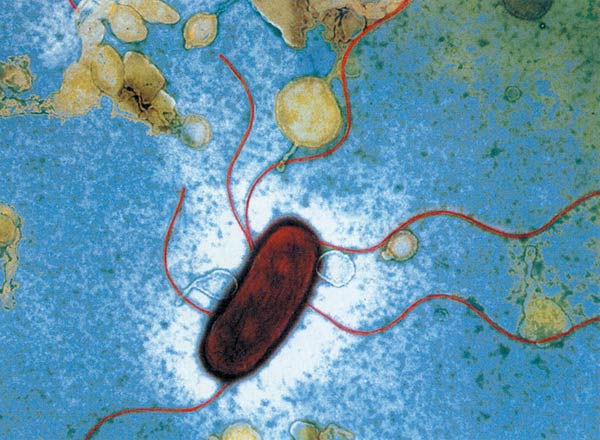 |
| Contrary to their expectations, the E. coli bacterium selected by evolutionists to prove evolution and discover its supposed mechanisms has remained unchanged for a billion years. |
The well-known evolutionist paleontologist Niles Eldredge is one of the most prominent adherents of the neo-Darwinist model known as punctuated equilibrium—in other words, the punctuated model of evolution, first put forward in the 1970s. (See Punctuated equilibrium.) According to this theory, evolution takes place not gradually, through small changes, but through very large and sudden ones.
The reason behind such a scenario (which actually contradicts the most basic claim of evolution) is that living species appear suddenly in the layers of the Earth in the same perfect forms they possess today.
For that reason, Eldredge—who shares the same views—claimed that evolution happened by way of large sudden changes, a claim that was entirely the product of the imagination.
Actually, this theory was a different version of the “Hopeful Monster” theory proposed by the German paleontologist Otto Schindewolf back in the 1930s. According to that theory, the first bird emerged from a reptile egg through an enormous change caused by a random mutation. Certain land-dwelling animals might also have turned into giant whales through a similarly sudden and wide-ranging change. But this theory was swiftly abandoned.
In order to impart a scientific character to their theory, Eldredge and Gould sought to develop a mechanism for these sudden evolutionary leaps. But the inconsistencies in this claim soon gave its authors reason for concern. Niles Eldredge stated, by way of a question, that the idea of living things progressing through evolution was logically flawed: Do plant and animal species really improve and develop into the more complex? If so, then should we consider the simple and unchanged life forms, such as the sponge, as evolutionary failures? He then added that the evolutionary motto “Progress is inevitable” should be replaced with “Why apes succeeded.” 136
This branch of science studies the developmental stages between the zygote phase that results from the fertilization of a living thing right through to birth. However, the concept of embryology is mostly used to describe a branch of biology that studies the development of animal embryos.
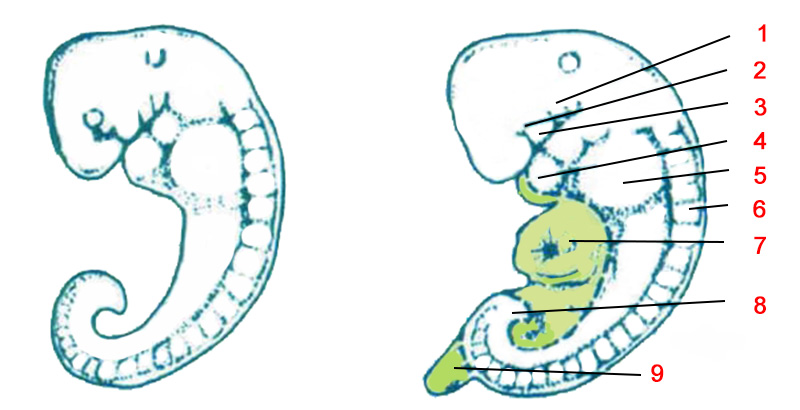 | |
| FALSIFIED DRAWING | ACCURATE DRAWING |
| 1.Folds | 6. Backbone |
| Above is an illustration drawn by Ernst Haeckel in order to prove a resemblance between the embryos of a human and a fish. When Haeckel’s drawing is compared with a genuine human embryo, it can be seen that he has deliberately removed a large number of the organs. | |
Until the 18th century, embryology was based more on speculation than on facts. The reason was that genetics had not yet been discovered, and the cell had not as yet been described. In general terms, the theory at that time was that initially, all of an animal’s organs were in a miniaturized state and only needed to open up and develop, like the petals of a flower. Many naturalists maintained that this initial state existed in the reproductive cells of a woman’s, ovary. This theory, proposed long before by Aristotle, maintained that the individual’s specialized structures developed gradually from non-specialized ones previously in the egg.137 But following the discovery under the microscope of sperm, the male reproductive cell, some scientists developed the hypothesis in 1677 that sperm carried the fertilizing agent.
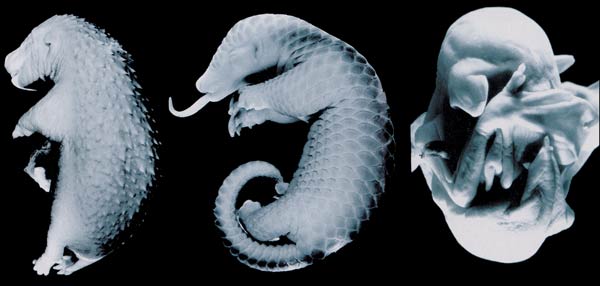 |
| Observations in recent years have revealed that the embryos of different life forms do not resemble each other at all in the manner suggested by Haeckel. The differences between the mammal, reptile and bat embryo shown above are a clear example of this. |
Subsequent research in the field of embryology was largely put forwards as evidence for evolution. But with the realization, that drawings and interpretations produced were fake, the situation was reversed, and embryological studies demonstrated that living things are created with a perfect system with mutually compatible components. (See Embryological evolution below, also Recapitulation.)
Any mammal undergoes a developmental process in its mother’s womb. The claim that embryological development in living things is evidence for evolution, however, is known as the Recapitulation theory in evolutionist literature. (See Recapitulation theory.) A number of evolutionist publications and textbooks today seek to portray this theory of recapitulation which had previously been removed from the scientific literature, as a scientific fact.
The term “recapitulation” is an abbreviated version of the “Ontogeny recapitulates phylogeny” axiom proposed by the evolutionist biologist Ernst Haeckel in the 19th century. Haeckel, the father of the recapitulation theory, resorted to fabricated drawings to back up his fictitious thesis. (See Haeckel, Ernst.) Certain circles who have conditioned themselves to support the theory of evolution still seek to portray his falsified drawings as evidence of embryological evolution.
According to Haeckel’s theory embryos repeat the evolutionary process during their developmental stages. The human embryo, for instance, first exhibits fish-like features and then reptilian ones during its development in the womb before finally resembling a human being.
In later years, however, it emerged that this scenario was wholly imaginary. The supposed gills that appeared during an embryo’s earliest stages were determined in fact to be the middle ear canal and the beginning of the parathyroid and thymus glands. That part of the embryo formerly compared to the yolk sac was revealed to be a sac producing blood for the baby. That part that Haeckel and his followers described as the tail is actually the backbone, which resembles a tail only because it develops before the legs.
These facts are known to everyone in the world of science. Evolutionists also accept them. As George Gaylord Simpson, one of the founders of neo-Darwinism, writes, “Haeckel misstated the evolutionary principle involved. It is now firmly established that ontogeny does not repeat phylogeny.” 138
That Haeckel’s theory is mere forgery is also accepted by the leading authorities of evolution. The world famous Science magazine announces this fact in its September 1997 issue under the title, “Haeckel's Embryos: Fraud Rediscovered.”
Not only did Haeckel add or omit features, Richardson and his colleagues report, but he also fudged the scale to exaggerate similarities among species, even when there were 10-fold differences in size. Haeckel further blurred differences by neglecting to name the species in most cases, as if one representative was accurate for an entire group of animals. In reality, Richardson and his colleagues note, even closely related embryos such as those of fish vary quite a bit in their appearance and developmental pathway. "It looks like it's turning out to be one of the most famous fakes in biology," Richardson concludes. 139
See “Ontology recapitulates phylogeny” theory, the.
This is one of the fossils that demolishes evolutionist claims regarding Archaeopteryx, showing that no evolutionary link can be established between birds and dinosaurs. The wing structure in Eoalulavis, approximately 30 million years older than Archaeopteryx, is exactly the same as that in slow-flying birds alive today. This feature considerably increases the bird’s maneuvering ability and provides extra control during landing and take-off.
The point is that a bird 30 million years older than Archaeopteryx was able to fly in a very effective manner. 140
This proves that neither Archaeopteryx nor any other birds like it were transitional forms.
This thesis was put forward in 1970 by Lynn Margulis, who claimed that bacterial cells turned into plant and animal cells as the result of symbiotic and parasitical activity. According to this thesis, plant cells emerged after a bacterium swallowed another photosynthetic bacterium cell. The photosynthetic bacterium supposedly evolved inside the devouring cell and turned into a chloroplast. Finally, organelles with very complex structures—such as the Golgi apparatus, endoplasmic reticulum and ribosome—somehow evolved inside the main cell. And thus plant cells came into being.
This thesis is nothing more than a figment of the imagination. Indeed, it has been criticized in many respects by many scientists regarded as authorities on the subject—D. Lloyd 141, Gray and Doolittle142 and Raff and Mahler, for example.
The fact on which the endosymbiosis thesis is based is that the chloroplasts inside the cell have their own DNA separate from that of the main cell. Based on that distinction, it is claimed that mitochondria and chloroplasts were once independent cells. Yet when chloroplasts are examined in detail, the invalidity of this claim becomes apparent.
The points that invalidate the endosymbiosis thesis are as follows:
1. If chloroplasts had really once been swallowed by a larger cell when they were living independently, as is claimed, then the only one result would have been their digestion and use as food by the main cell. Even if we assume that the main cell did mistakenly absorb these cells instead of food, its enzymes would have digested them. Naturally, evolutionists may try to gloss over this point by claiming that the digestive enzymes had disappeared. But this is a manifest contradiction. If the digestive enzymes had vanished, then the main cell would have died for lack of nourishment.
2. Again, assume that all these impossible events actually took place and that the cells claimed to be the forerunners of chloroplasts were swallowed by the main cell. We now face another problem: the blueprint for all the organelles in the cell is encoded in DNA. If the main cell is to use as organelles other cells it has engulfed, then it needs to have the information concerning them coded in its DNA beforehand. Indeed, the DNA of the swallowed cells would have to possess information regarding the main cell. Such a thing is of course impossible. No living thing carries genetic information for an organ it does not possess. It is impossible for the DNA of the main cell and that of the engulfed cells to have later adapted to one another.
3. Within the cell, there is enormous harmony. Chloroplasts do not act independently of the cell to which they belong. In addition to being dependent on the main DNA in protein synthesis, the chloroplasts do not make the decision to multiply themselves. In any one cell, there are more than one chloroplast and mitochondrion. Just as with other organelles, their numbers rise or fall in line with cell activity. The fact that these organelles contain their own separate DNA is of particular benefit when it comes to replication. As the cell divides, the chloroplasts also separate in two, thus doubling their numbers, so that cell division takes place more quickly and orderly.
4. Chloroplasts are vitally important generators of energy for the plant cell. If these organelles are unable to do so, many of the cell’s functions cannot take place, and the organism will be unable to survive. These vitally important functions take place with proteins synthesized in the chloroplasts. However, the chloroplasts’ own DNA is not sufficient for them to synthesize these proteins. The great majority of proteins are synthesized using the cell’s main DNA.143
It is absolutely impossible for such harmony to have developed through trial and error. Any change in a DNA molecule will not gain the organism any new characteristic, but will definitely harm it.
Mahlon B. Hoagland describes the position in his book The Roots of Life:
You’ll recall we learned that almost always a change in an organism’s DNA is detrimental to it; that is, it leads to a reduced capacity to survive. By way of analogy, random additions of sentences to the plays of Shakespeare are not likely to improve them! . . . The principle that DNA changes are harmful by virtue of reducing survival chances applies whether a change in DNA is caused by a mutation or by some foreign genes we deliberately add to it. 144
Evolutionists did not produce their claims on the basis of any scientific experiments. No such phenomenon as one bacterium swallowing another has ever been observed. The molecular biologist Whitfield describes the situation:
Prokaryotic endocytosis [the taking in of matter by a living cell] is the cellular mechanism on which the whole of S.E.T. (Serial Endosymbiotic Theory) presumably rests. If one prokaryote could not engulf another, it is difficult to imagine how endosymbiosis could be set up. Unfortunately for Margulis and S.E.T., no modern examples of prokaryotic endocytosis or endosymbiosis exist . . . 145
There is no example of a bacteria that is left intact, without being digested, after being engulfed by another and which ‘contributes’ to the initiation of an even more complex cell in nature. Such a relationship between two bacteria is not definitely demonstrated in any laboratory experiments. That means such organisms are not alive in nature or in test tubes, but only in the minds of evolutionists. In reality, genes of eukaryotic cells are much different than the ones in prokaryotic ones and no evolutionary relationship exists in between them. D.F. Doolittle has a confession in an article in the Scientific American magazine:
... many eukaryote genes are totally unlike those seen in the prokaryotes and archaea. They seem to come from no-where. 146
—See, Second law of Thermodynamics, the.
Evolutionists have set out horse fossils out in a series, from small to larger. Yet evolutionists do not agree on regarding these family trees concerning the horse’s supposed evolution. The only point they agree upon is their belief that a dog-like mammal known as Eohippus (Hyracotherium) that lived in the Eocene period 55 million years ago is the first forerunner of the horse. Yet Eohippus, portrayed as an equine ancestor that became extinct millions of years ago, is almost identical to the mammal known as Hyrax that still lives in Africa, but has not the slightest connection with horses. 147
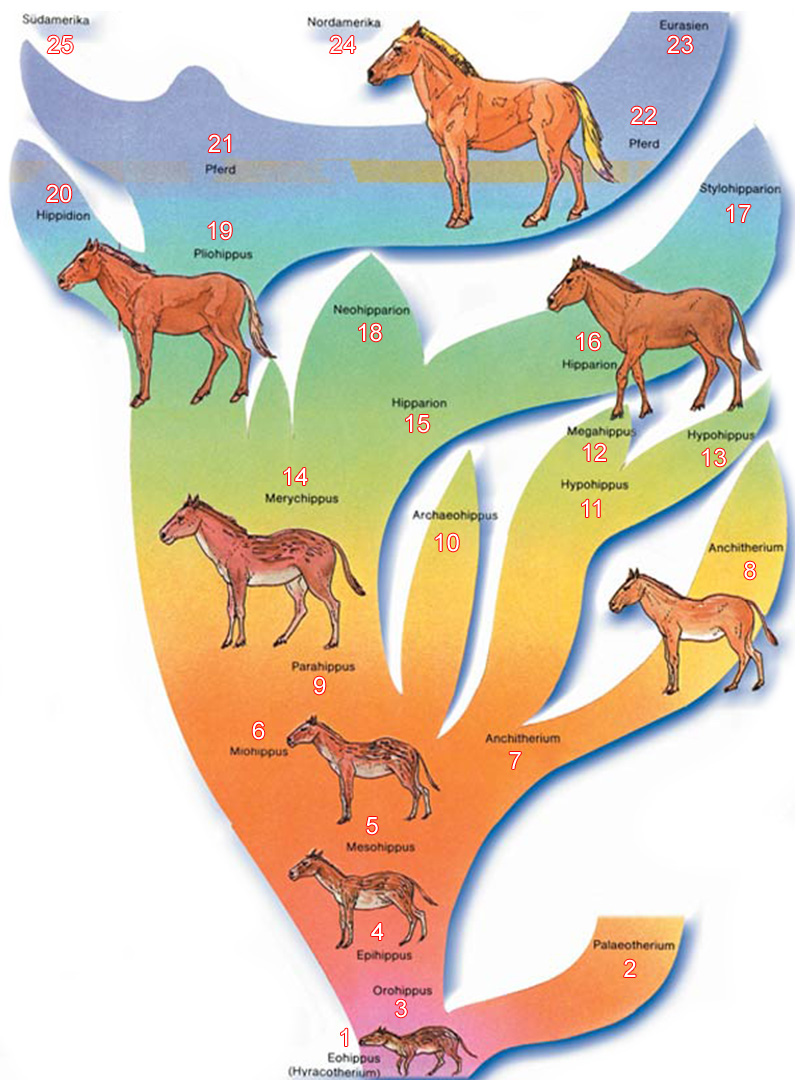 |
| Fossils of Eohippus, the supposed ancestor of the horse, and breeds of horse still alive today have all been found in the same strata. |
The invalidity of the claim regarding the evolution of the horse is becoming clearer every day with the discovery of new fossils. Eohippus has been identified in strata containing some fossilized breeds of horse—Equus nevadensis and E. occidentalis—that are still alive today—Equus nevadensis.148 This shows that the modern horse lived at the same time as its supposed forebear, proving that the horse never underwent the process known as evolution.
In his book The Great Evolution Mystery, the evolutionist writer Gordon Rattray Taylor describes the horse series myth:
But perhaps the most serious weakness of Darwinism is the failure of paleontologists to find convincing phylogenies or sequences of organisms demonstrating major evolutionary change. . . The horse is often cited as the only fully worked-out example. But the fact is that the line from Eohippus to Equus is very erratic. It is alleged to show a continual increase in size, but the truth is that some variants were smaller than Eohippus [the first in the sequence], not larger. Specimens from different sources can be brought together in a convincing-looking sequence, but there is no evidence that they were actually ranged in this order in time. 149
All these facts reveal that the horse evolution-trees, portrayed as one of the strongest pieces of evidences for evolution, are imaginary and worthless. Like other species, horses were brought into being with no evolutionary forebears. (See Origin of the Horse, the.)
—see Root of Plant Cell, the
 |
| The current effects of the concept of eugenics are reflected in the way the handicapped are treated. To the right can be seen a handicapped child excluded from society, and whose hands have even been tied. |
The theory of eugenics, which attracted many adherents in the first half of the 20th century, called for the eradication of deformed and sick people and the improvement of a human race by means of the multiplication of healthy individuals. According to the theory of eugenics, humanity can be improved in the same way that breeds of animals can—by mating strong, healthy animals together.
The people who first proposed the theory of eugenics were Darwinists. Charles Darwin’s nephew, Francis Galton, and his son Leonard Darwin led the eugenics movement in Britain. From that point of view, the concept of eugenics emerged as a natural consequence of Darwinism. That fact was specially emphasized in publications supporting eugenics – “Eugenics is mankind directing its own evolution,” they stated.
According to K. Ludmerer, the idea of eugenics was as old as Plato’s famous work The Republic. However, Ludmerer states that Darwinism was the reason why interest in the idea increased:
. . . modern eugenics thought arose only in the nineteenth century. The emergence of interest in eugenics during that century had multiple roots. The most important was the theory of evolution, for Francis Galton’s ideas on eugenics—and it was he who created the term “eugenics”—were a direct logical outgrowth of the scientific doctrine elaborated by his cousin, Charles Darwin. 150
Following the development of Darwinism and the idea of eugenics, racist scientists in Germany began openly advocating the killing of unwanted individuals. One of these scientists, Adolf Jost, called for unwanted people to be medically put down in his 1895 book Das Recht auf den Todt (“The Right to Die”). Jost claimed that “the state needs to assume the responsibility for killing individuals for the health of the social organism.”
Jost was the intellectual inspiration behind Adolf Hitler, who would emerge onto the world stage 30 years later. Along the same lines, Hitler said, “The state must ensure that only healthy children exist. The visibly sick and those carrying infectious diseases must be declared to be unfit.”151
Shortly after coming to power, Hitler initiated an official policy of eugenics, which he summarized in these words:
Mental and physical education occupy an important place for the state, but human selection is just as important. The state has a responsibility to declare that the genetically sick or individuals with infectious diseases are unfit to breed . . . . And that responsibility must be ruthlessly enforced, showing no compassion and without expecting others to understand. . . . To stop the crippled or physically sick from reproducing over a period of 600 years. . . will lead to improvement in human health that cannot be obtained today. If the healthiest members of the race breed in a planned manner. . . then a race will emerge that bears no mentally or physically defective seeds of the kind we still carry today. 152
As a requirement of this policy of Hitler’s, the mentally ill, crippled, those born blind and the genetically sick in German society were regarded as parasites who damaged the purity and universal progress of the German race. These people were rounded up and sterilized. Not long after, these people who had been removed from society began being killed, following a secret directive issued by Hitler.
Under a law passed in 1933; 350,000 mental patients, 30,000 gypsies and hundreds of black children were sterilized by such methods as x-rays, injection or electric shocks to the genitals. One Nazi officer said, “National Socialism is nothing more than applied biology.”153
Hitler sought to accelerate the supposed evolution of the German race with these killings and ruthless measures aimed at innocent people, and also brought in eugenics. Blond, blue-eyed young men and women whom he regarded as representatives of the German race were encouraged to have children together. In 1935, special breeding farms were established for this purpose. Young girls who met racial criteria were sent to these farms, which, were constantly visited by SS units. The illegitimate children born on these farms were to be raised as the citizens of the 1000-year Reich.
—see, Origin of the plant cell, the.
After the capture of a living Coelacanth, evolutionists realized that this was not a transitional form. So they next settled on depicting the fish E. foordi as a transitional “missing link.”
Evolutionists maintained that that the tailed water frog was descended from E. foordi. However, anatomical comparisons of tailed water frog and Eusthenopteron revealed profound differences between the two. This meant that evolutionists had to suppose another transitional form between them. However, no skeleton belonging to this theoretical transition between Eusthenopteron foordi and the tailed water frog Icthyostega has ever been found.
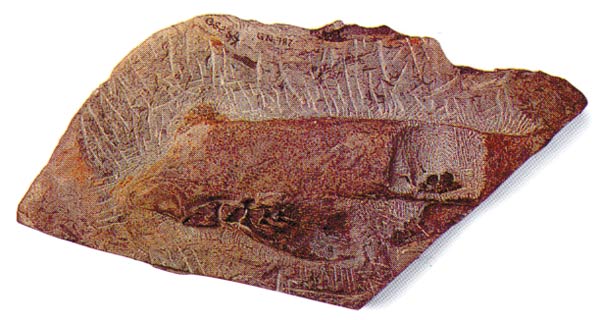 |
| A Eusthenopteron foordi fossil dating to the late Devonian Period, found in Canada. |
Now, the two favorite subjects for most of the contemporary evolutionary scenarios regarding tetrapod origins are Eusthenopteron (an extinct fish) and Acanthostega (an extinct amphibian). Robert Carroll, in his Patterns and Processes of Vertebrate Evolution, makes comments on these allegedly related forms:
Eusthenopteron and Acanthostega may be taken as the end points in the transition between fish and amphibians. Of 145 anatomical features that could be compared between these two genera, 91 showed changes associated with adaptation to life on land . . . This is far more than the number of changes that occurred in any one of the transitions involving the origin of the fifteen major groups of Paleozoic tetrapods. 154
 |
| There is no process of evolution behind the origin of frogs. The earliest known frogs emerged totally different from fish and with their own unique structures. There is no difference between this frog fossil preserved in amber, discovered in the Dominican Republic, and living specimens |
The neo-Darwinist model we refer to today as the theory of evolution proposes two basic evolutionary mechanisms; natural selection and mutation. According to the theory’s basic proposition, these two mechanisms are mutually complementary. The source of evolutionary changes is random mutations in the genetic structure of living things. Again according to the theory, natural selection favors the most advantageous characteristics caused by mutations, and thus living things evolve.
However, these proposed mechanisms actually have no evolutionary force at all. And there is no question of them giving rise to new species, as evolutionists claim. (See Natural selection and Mutation.)
—See Tree of Life and Imaginary family tree of Man, the.)
Many people imagine the theory of evolution to have been formulated by Charles Darwin and to be based on scientific evidence, observations and experiments. However, the source of the theory is not its intellectual founding father, Darwin, nor any scientific evidence.
At a time when pagan religions dominated Mesopotamia, many beliefs and myths abounded regarding the origin of life and the universe. One of these, surprisingly, was a belief in evolution! According to an inscription from Sumerian times, known as the Enuma-Elish, there was initially watery chaos, out of which two gods, Lahmu and Lahamu, suddenly emerged. According to this myth, these deities first brought themselves into being and then gave rise to other substances and living things. In other words, according to the Sumerian legend, life emerged suddenly out of watery chaos and developed by way of evolution.
The evolution myth later flourished in another pagan civilization—ancient Greece. Athenian philosophers regarded matter as the only absolute entity. They turned to the myth of evolution, inherited from the Sumerians, to explain how life arose. Materialist philosophy and the myth of evolution thus came together in ancient Greece, whence they were transplanted to Roman culture.
The idea that all living things had one common ancestor, maintained by the theory of evolution, was put forward by the French biologist the Comte de Buffon in the mid-18th century. (See Buffon, Comte de.) Charles Darwin’s grandfather, Erasmus Darwin, developed de Buffon’s idea and came up with the first basic propositions representing the concept we today know as the theory of evolution. (See Darwin, Erasmus.)
 |
| Like modern-day materialists, the ancient Greek materialist philosopher Democritus made the error of thinking that matter was eternal and nothing existed apart from matter. |
After Erasmus Darwin, the French natural historian Jean Baptiste Lamarck proposed the first wide-ranging theory of evolution at the beginning of the 19th century. (See Lamarck, Jean Baptiste.) According to him, evolution operated through “acquired characteristics being passed on from generation to generation.” In his view, the changes that living things underwent during the course of their lives were permanent and could be passed on genetically to their offspring.
Lamarck’s theory enjoyed enormous success at the time it was launched. But afterwards, that popularity declined rapidly. People with justified doubts regarding Lamarck’s theories began carrying out their own research.
In 1870, the British biologist Weismann proved that acquired characteristics could not be passed on to subsequent generations and therefore, Lamarck’s theory was wrong. Therefore, the teaching today imposed on us and the entire world as the theory of evolution is not actually based on Lamarck. The birth of Darwinism, known as the theory of evolution the world around, came with the 1859 publication of Charles Darwin’s book The Origin of Species by Means of Natural Selection or the Preservation of Favoured Races in the Struggle for Life.
Darwin removed certain obvious logical errors from Lamarck’s theory and produced the natural selection thesis rather than a genetic explanation for the evolution of living things.
His theory of evolution denies that living things were created and maintains that they are the product of natural processes and random influences. According to this theory, all living things are descended from one another. A previously existing living species gradually developed turned into another, and eventually, all species emerged in this way. The transition took hundreds of millions of years and was carried forward in stages. Though the theory was been widely accepted for around a century and a half, today it finds itself in conflict with findings from a great many branches of science such as paleontology, biochemistry, anatomy, biophysics and genetics.
Though the theory of evolution has no scientific foundation, most people around the world regard it as scientific fact. The most important reason for this error is systematic indoctrination and propaganda from the media.
In their reports, the media giants employ an assumption that the theory of evolution is as certain as any mathematical law. The most classic example of this comes with regard to fossil remains. Sentences such as “According to a Time magazine report, a very significant fossil filling a gap in the chain of evolution has been discovered,” or “According to a report in Nature, scientists have clarified the final missing parts in the evolutionary puzzle” are printed in large, bold face. However, nothing has actually been proven at all for the final missing link in the evolutionary chain to have been found. All the evidence put forward is false.
On the other hand, despite there being millions of fossils of living things in perfectly formed states, no transitional form fossil that might confirm an evolutionary development has ever been found. In his 1991 book Beyond Natural Selection, the American paleontologist R. Wesson describes the significance of the real and concrete gaps in the fossil record:
The absence of a record of any important branching is quite phenomenal. Species are usually static, or nearly so, for long periods, species seldom and genera never show evolution into new species or genera but replacement of one by another, and change is more or less abrupt. 155
This shows that the argument that “Transitional-form fossils have not been found yet, but may be in the future,” put forward by evolutionist for the last century and a half, no longer has any validity. The fossil record is sufficiently rich for us to understand the origin of life, and from it a very concrete picture emerges: different living species appeared suddenly and separately on Earth, with all their different structures, and with no transitional forms between them.
Julian Huxley, one of Darwin’s leading supporters, sought to place the latter’s biological argument onto a philosophical footing and constructed a new religion under the name of evolutionary humanism.
The aim of this religion was to “ensure that the evolutionary process on Earth reached its maximum conclusion.” This was not restricted to strong organisms living longer and trying to reproduce more offspring. In addition, “it was foreseen that man would develop his own abilities to the highest level.” To put it another way, efforts were to be made to enable mankind to proceed to stages more advanced than the one that human beings are in today. Huxley offered a full definition of the term Humanism:
I use the word ‘Humanist’ to mean someone who believes that man is just as much a natural phenomenon as an animal or a plant, that his body, his mind, and his soul were not supernaturally created but are all products of evolution, and that the is not under the control or guidance of any supernatural Being or beings, but has to rely on himself and his own powers. 156
Huxley’s suggestion that human beings’ sacred aim was to accelerate their own evolution had a profound effect on the American philosopher John Dewey. He developed this line and founded the movement known as Religious Humanism in 1933, publishing the famous Humanist Manifesto. The main idea he emphasized was that the time had come for the traditional Theistic (God-oriented) religions to be done away with and replaced by a new system based on scientific progress and social cooperation.
The deaths of 50 million people in World War II as a result of “scientific progress” rocked the optimism exhibited in the Humanist Manifesto. In the wake of similar blows, Dewey’s followers were forced to partially revise their views, and they published the second Humanist Manifesto in 1973. This one admitted that science may sometimes harm mankind, but preserved the basic idea: Man should now direct his own evolution and could do so through science. As the Manifesto said:
Using technology wisely, we can control our environment, conquer poverty, markedly reduce disease, extend our life-span, significantly modify our behavior, alter the course of human evolution and cultural development, unlock vast new powers, and provide humankind with unparalleled opportunity for achieving an abundant and meaningful life. 157
In fact these ideas, adopted consciously or subconsciously by all Darwinists, make crystal clear the fundamental beliefs of the Religion of Evolution. An imaginary process of species evolution is first dreamed up, and it is then assumed that this process is the creator of everything. The further, it is thought that this process can represent salvation for humanity, and it is believed that humanity’s sacred destiny is to serve that process. In short, evolution is both a Creator, and a savior, and a sacred purpose. To short, it is worshipped as a deity.
Some people believe in Divine religions revealed to them by God. Others, are devoted to religions they have made up for themselves or that have been produced by the society they live in. Some worship totems, others the Sun, while others beseech beings from outer space.
These second groups ascribe partners to God and are commonly defined as pagans in Western literature.
Evolutionists also adopt the theory of evolution, and indeed use science as a general religion. These people say they place their faith in scientific fact proven by means of concrete evidence. They also regard themselves as representatives of a concrete reality, superior to religion. These deceptive claims of evolutionist pagans place them in an imaginary position above other religious believers. For them, accordingly, other religions are subjective beliefs, whereas evolution is an objective reality. Using the false authority bestowed by this deception, they call on other religious believers to follow them. According to the evolutionist’s argument, if other religions accept evolution and the concepts that follow from it, then all socio-political measures based on evolution will be perceived as a moral teaching.
George Gaylord Simpson, one of the most important figures in the neo-Darwinist movement, makes this clear:
Of course there are some beliefs still current, labeled as religious and involved in religious emotions that are flatly incompatible with evolution and therefore are intellectually untenable in spite of their emotional appeal. Nevertheless, I take it as now self-evident, requiring no further special discussion, that evolution and true religion are compatible.158
This implies that evolution and the scientific teachings developed on the basis of it have the authority to judge other religions. It will be up to evolutionist science to decide which religions or which interpretation will be regarded as the “true” one. The teaching referred to as true religion makes no claims regarding the observable universe and that makes do solely with setting out moral criteria for human beings. Everything to do with the observable universe—science, economics, politics, law, etc—is to be determined in the light of an evolutionary conception.
While this totalitarian approach imposes the theory of evolution on society as a scientific fact, it also keeps a tight reign on scientific circles. Most present-day biologists worship the pagan religion in question, and any who do not share that belief are silenced. In this system, the theory of evolution becomes a sacred cow. Scientists who reject evolution lose any chance of rising in their careers.
The well-known professor of anatomy Thomas Dwight describes this as an intellectual dictatorship:
The tyranny of the zeitgeist in the matter of evolution is overwhelming to a degree of which outsiders have no idea. Not only does it influence (as I admit it does in my own case) our manners of thinking, but there is oppression as in the days of the Terror. How very few of the leaders of science dare tell the truth concerning their own state of mind. 159
135.Pierre-Paul Grassé, Evolution of Living Organisms, New York: Academic Press, , 1977, p. 87. 
136.Niles Eldredge, “Is Evolution Progress?” Science Digest, September 1983, pp. 40, 160. 
137.137 http://www.repromed.org.uk/history/history_ 1500.htm. 
138.G.G. Simpson, W. Beck, An Introduction to Biology, New York: Harcourt Brace and World, 1965, p. 241. 
139.Elizabeth Pennisi, “Haeckel's Embryos: Fraud Rediscovered”, Science, 5 September 1997: Vol. 277. no. 5331, p. 1435. 
140.Pat Shipman, “Birds Do It. . . Did Dinosaurs?,” New Scientist, p. 28. 
141.D. Loyd, The Mitochondria of Microorganisms, 1974, p. 476. 
142.Gray & Doolittle, “Has the Endosymbiant Hypothesis Been Proven?,” Microbiological Review, Vol. 30, 1982, p. 46. 
143.Wallace-Sanders-Ferl, Biology: The Science of Life, 4th Edition, Harper Collins College Publishers, p. 94. 
144.Mahlon B. Hoagland, The Roots of Life, p. 145. 
145.Whitfield, “Book Review of Symbiosis in Cell Evolution”, Biological Journal of Linnean Society, Vol. 77-79 1982, p. 18. 
146.W. Ford Doolittle, "Uprooting the Tree of Life," Scientific American, 282:90, February 2000. 
147.Francis Hitching, The Neck of the Giraffe: Where Darwin Went Wrong, pp. 16-17, 19 
149.Gordon Rattray Taylor, The Great Evolution Mystery, London: Sphere Books, 1984, p. 230. 
150.K. Ludmerer, Eugenics, In: Encyclopedia of Bioethics, edited by Mark Lappe, New York: The Free Press, 1978, p. 457. 
151.http://www.trufax.org/avoid/nazi.html; Theodore D. Hall, Ph. D., Scientific Background of Nazi ‘Race Purification’ Program, Leading Edge International Research Group. 
152.A. E. Wilder Smith, Man’s Origin, Man’s Destiny, A Critical Survey of the Principles of Evolution and Christianity, The Word For Today Publishing 1993, pp.163, 16. 
153.Henry Morris, The Long War Against God, p. 78; Francis Schaeffer, How Shall We Then Live?, Old Tappan, NJ: Revell Books, , 1976, p. 151. 
154.Maria Genevieve Lavanant, Bilim ve Teknik magazine, April 1984, No. 197, p. 22. 
155.R. Wesson, Beyond Natural Selection, Cambridge, MA: MIT Press, 1991, p. 45. 
156.Huxley, J. as cited in The Best of Humanism, ed. Roger E. Greeley. Buffalo, NY: Prometheus, 1988. pp. 194-5. 
157.http://www.jcn.com/manifestos.html 
158.Phillip E. Johnson, “Evolution as Dogma: The Establishment of Naturalism,” http://www.arn.org/docs/johnson/pjdogma1.htm. 
159.Thomas Dwight, Thoughts of a Catholic Anatomist. London: Longmans Green & Co, 1927, pp. 20-21. 